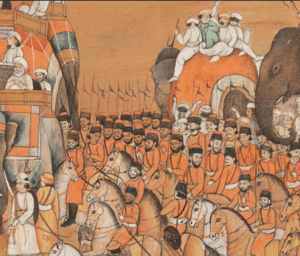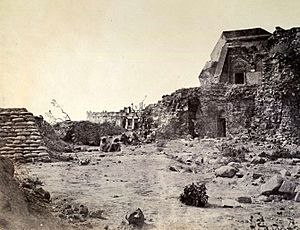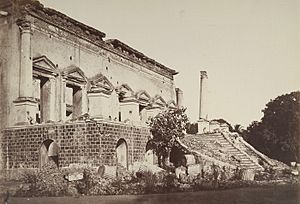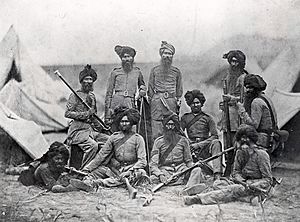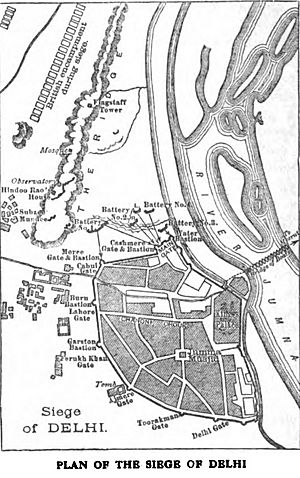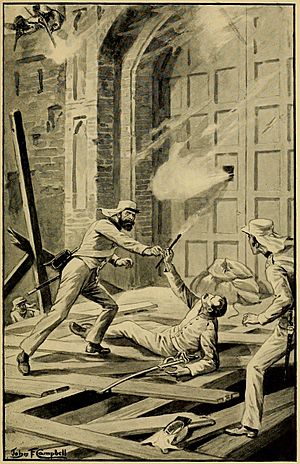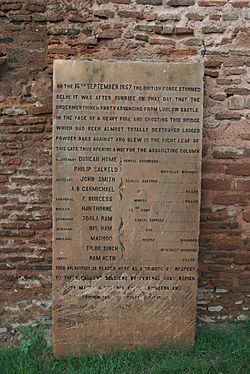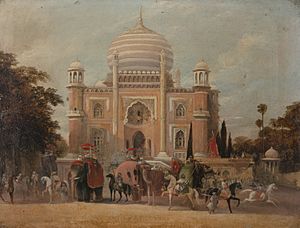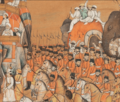Siege of Delhi facts for kids
Quick facts for kids Siege of Delhi |
|||||||
|---|---|---|---|---|---|---|---|
| Part of the Indian Rebellion of 1857 | |||||||
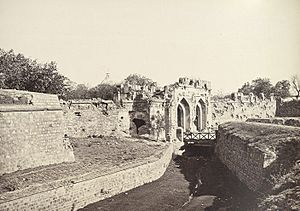 Battle damage to the Kashmiri Gate in Delhi, 1857. |
|||||||
|
|||||||
| Belligerents | |||||||
|
|
|||||||
| Commanders and leaders | |||||||
|
|
||||||
| Strength | |||||||
| 3,000 regular 6000 Sikhs, Punjabis, and Gurkhas 2,200 Kashmiri irregulars 42 field guns 60 siege guns |
12,000 sepoys, approx. 30,000 irregulars or Muslim warriors, approx. 100 guns |
||||||
| Casualties and losses | |||||||
| 1,254 killed 4,493 wounded |
approx. 5,000 killed and wounded | ||||||
The Siege of Delhi was a very important battle during the Indian Rebellion of 1857. This rebellion was against the power of the East India Company, a British trading company that ruled much of India.
The rebellion started with Indian soldiers, called sepoys, who worked for the East India Company. They wanted to bring back the old Mughal Empire, which had ruled India for centuries. Many rebels gathered in Delhi, making it a key place for the fight.
The siege was important for two reasons. First, many rebels gathered in Delhi to defend it. Their defeat there was a big loss for the rebellion. Second, when the British took Delhi back, the old Mughal Emperor, Bahadur Shah II, gave up. This made the rebellion lose its national symbol. Even though rebels still held other areas, they weren't working together. This allowed the British to defeat them one by one.
Contents
How the Rebellion Started
For several years, there was growing tension among the sepoys, who were Indian soldiers working for the British East India Company. The rebellion openly began in Meerut, a town near Delhi.
The main spark was a new rifle, the Pattern 1853 Enfield. Soldiers believed its cartridges were greased with animal fat from cows and pigs. To load the rifle, they had to bite open the cartridges. This was against the religious beliefs of both Hindu and Muslim soldiers.
On May 9, 1857, 85 soldiers in Meerut refused to use the cartridges. They were put in prison. The next day, other Indian soldiers rebelled. They freed the prisoners and killed their British officers and many British people in the area.
The British officers in Meerut were surprised. They knew there was unrest, but they thought Meerut was safe because there were many European troops there. Luckily for the British, the rebellion started on a Sunday evening. The European soldiers were still in their barracks and could quickly get their weapons.
The British commanders in Meerut did not do much. They only defended their own areas. They also did not warn nearby British bases, even though they could have sent messages to Delhi quickly. The rebels then marched towards Delhi.
Rebels Capture Delhi
Delhi was the capital of the Mughal Empire, but its power had greatly reduced. The emperor, Bahadur Shah II, was 82 years old. The East India Company had told him that his title would end when he died. Delhi was not a major British center, but Company officials controlled its money and courts. They lived in an area north of the city.
There were no British Army troops in Delhi. Three Indian regiments of the East India Company were stationed outside the city. They guarded buildings, including the main guard post near the Kashmiri Gate and the arsenal inside the city. On May 11, the soldiers were told about the execution of another sepoy, Mangal Pandey, who had tried to start a rebellion earlier. This made the soldiers very angry.
Later that morning, the rebels from Meerut arrived unexpectedly. They crossed the Jumna River and called on the Emperor to lead them. Bahadur Shah told them to go to another palace. British officials tried to close the city gates, but it was too late. The rebels entered the city. Once inside, they were joined by angry crowds. They began attacking British officials and looting shops.
Some British officers and civilians tried to hide in the Main Guard building. But the Indian soldiers there joined the revolt and killed them. Other officers arrived and briefly took back the Main Guard. Meanwhile, nine British officers led by George Willoughby were defending the arsenal, which held many weapons and ammunition. Their Indian troops left them. The British officers fired on their own troops and the crowds to stop the arsenal from falling into rebel hands. After five hours, they blew up the magazine, killing many people and damaging buildings. Only three officers escaped and received the Victoria Cross, a medal for bravery.
Soon after, the troops at the Main Guard were ordered to leave. The Indian soldiers there, who had not joined the revolt before, now turned on their officers.
About half of the European civilians in Delhi managed to escape. They first went to the Flagstaff Tower, where telegraph operators tried to warn other British bases. When it became clear no help would arrive, most Europeans fled to Karnal, a town many miles away. Some villagers helped them, while others were attacked by looters.
Mughal Emperor's Role
On May 12, Bahadur Shah held a formal meeting. Rebellious soldiers attended and were disrespectful to him. Even though Bahadur Shah was upset by the looting, he publicly supported the rebellion. On May 16, soldiers and palace servants killed 52 British prisoners inside the palace. This happened despite Bahadur Shah's protests. The killers wanted to involve the Emperor in the killings, so he could not make peace with the East India Company.
The city's new administration was very messy. The Emperor named his son, Mirza Mughal, as the army's commander. But Mirza Mughal had little military experience and the soldiers did not respect him. The soldiers also did not agree on one overall commander. Each regiment only listened to its own officers. Mirza Mughal tried to bring order to the city, but his power did not go beyond its walls. Outside Delhi, local groups started charging their own taxes, making it hard to get food into the city.
News of the rebellion in Meerut and Delhi spread quickly across India. Rumors and messages from the rebels caused more uprisings. However, the East India Company learned about the events in Delhi even faster, thanks to the telegraph. Where British commanders were quick and did not trust their Indian soldiers, they were able to stop some dangerous revolts.
British Actions
Even though there were British troops in the cool "hill stations" in the Himalayas, it took time to get them to Delhi. This was because there were not enough ways to transport them or their supplies. The East India Company had cut back on transport units to save money. Also, many senior British officers were very old and slow to act.
However, a British force led by General George Anson started moving towards Delhi on May 17. On June 7, they met another force from Meerut. General Anson died of a disease called cholera on May 27. Major General Henry Barnard took command. The combined force then moved towards Delhi.
On June 8, they found the rebels had built defenses outside the city. The British defeated the large but disorganized rebel force at the Battle of Badli-ki-Serai, west of Delhi. They then captured Delhi Ridge, a high area north of the city. They also burned the Indian army barracks nearby. This was a bad idea, as it forced the British soldiers to live in tents during the hot summer and monsoon rains.
The ridge was about 60 feet high. It stretched from near the city walls to the Yamuna River. Luckily for the British, a canal ran near their camp, protecting their rear and providing drinking water. The British set up fortified posts along the ridge. The closest and most dangerous post was called "Hindu Rao's house." South of it was a maze of villages and gardens where rebels could gather for attacks.
The Siege: June and July
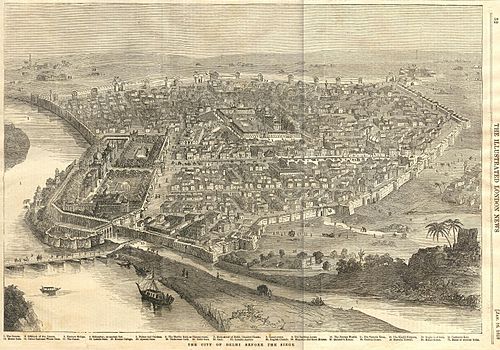
It quickly became clear that Delhi was too strong to be taken by a quick attack. General Barnard ordered an assault on June 13, but the orders were mixed up, and the attack was called off. After this, everyone agreed that the British needed more soldiers before they could attack.
Many more rebellious Indian soldiers and volunteers kept arriving in Delhi. During June and July, many regiments of cavalry and infantry joined the rebels. Large numbers of irregular fighters, mostly Muslim warriors, also arrived. Each time new groups arrived, the rebels attacked Hindu Rao's house and other British outposts. A big attack happened on June 19, almost forcing the tired British to retreat. Another major attack was on June 23, the 100th anniversary of the Battle of Plassey. Many believed British rule in India would end exactly 100 years after that famous battle.
Even though the British fought off all these attacks, their soldiers became very tired and sick. Conditions on the ridge were unhealthy. General Barnard died of cholera on July 5. His replacement, General Reed, also got cholera and had to give command to Archdale Wilson. Wilson tried to clean up the camp and reorganize the troops, but he was also very tired. Another brave officer, Brigadier Neville Chamberlain, was badly wounded on July 14.
Meanwhile, inside Delhi, the rebels were losing hope because Mirza Moghul and the Emperor's grandson were not good leaders. Then, a large group of reinforcements arrived from Bareilly led by Bakht Khan. He was an experienced artillery officer from the Company's army. Bahadur Shah was happy with the supplies they brought and made Bakht Khan the new commander-in-chief. Bakht Khan helped the city's finances and encouraged the rebel soldiers. However, Bahadur Shah was becoming discouraged and turned away help from other rebel leaders.
The Siege: August and September
In the Punjab, a part of India that the East India Company had taken over only eight years before, the Indian regiments were quickly disarmed or defeated if they rebelled. Most of the available British troops were there, along with units made of Sikhs and Pakhtuns. These groups did not get along with the high-caste Hindus who made up many of the rebellious Indian soldiers.
As the situation in Punjab became stable, more troops could be sent to Delhi. Also, the rulers of states like Patiala and Nabha agreed to help the East India Company. They sent their armies to protect the supply routes to Delhi.
The first reinforcements to arrive at Delhi were the Corps of Guides. They marched hundreds of miles in the hottest part of the year. Despite this, they went into battle almost immediately.
The main force sent from Punjab was a "Flying Column" of 4,200 men led by Brigadier John Nicholson, along with a "siege train" (heavy cannons and equipment). Nicholson himself arrived on August 14. The rebels had heard about the siege train coming and sent a force to stop it. On August 25, Nicholson led his troops against them at the Battle of Najafgarh. Even though it was monsoon season and the roads were flooded, Nicholson marched quickly and won an easy victory. This boosted British morale and lowered the rebels'.
The siege train arrived in early September. It included many large cannons and mortars, with almost 600 carts of ammunition. By September 8, the British had a total of 15 large cannons, 20 smaller cannons, and 25 mortars and howitzers.
Capturing Delhi
The Bombardment
By early September, the British had about 9,000 soldiers. This included 3,000 regular troops and 6,000 Sikhs, Punjabis, and Gurkhas.
Wilson's chief engineer, Richard Baird Smith, created a plan to break through the city walls and attack. Wilson was hesitant to attack, but Nicholson strongly urged him to agree. Some British officers, including Nicholson, even considered replacing Wilson if he didn't agree to the attack.
First, on September 6, the British built a battery of cannons to silence the rebel guns on the Mori Bastion. Then, on September 7, the first main siege battery was set up 700 yards from the Mori Bastion. It started firing on September 8. Its guns attacked the Kashmir Bastion, while others silenced the rebel guns on the Mori Bastion. This attack also tricked the rebels into thinking the main assault would come from the east, not the north.
A second battery of large cannons and howitzers was set up near "Ludlow Castle" and began firing on the Kashmir Bastion on September 10. A third battery of cannons and mortars was set up very close to the city walls and fired on the Water Bastion the next day. A fourth battery of heavy mortars was set up on September 11. Because the rebels now knew where the attacks were coming from, the Indian engineers who built these batteries suffered over 300 casualties. But the cannons quickly made holes in the city walls. Fifty guns fired day and night, and the walls began to crumble.
At this point, the rebels seemed to run out of ammunition they had taken from the arsenal. Their firing became much weaker. Also, the rebels were losing hope due to lack of supplies and money. Spies working for William Hodson spread rumors that made them even more discouraged.
Preparing for the Attack
The attack was planned for 3 a.m. on September 14. The attacking groups moved into position on the night of September 13. Lord Roberts, who was a young officer then, wrote down how the groups were made up:
- 1st Column – Led by Brigadier General Nicholson
- 75th Foot – 300 soldiers
- 1st Bengal Fusiliers – 250 soldiers
- 2nd Punjab Infantry – 450 soldiers
- Total – 1000 soldiers
- 2nd Column – Led by Brigadier Jones
- 8th Foot – 250 soldiers
- 2nd Bengal Fusiliers – 250 soldiers
- 4th Sikhs – 350 soldiers
- Total – 850 soldiers
- 3rd Column – Led by Colonel Campbell
- 52nd Foot – 200 soldiers
- Kumaon Battalion (Gurkhas) – 250 soldiers
- 1st Punjab Infantry – 500 soldiers
- Total – 950 soldiers
- 4th Column – Led by Major Reid
- Sirmur Battalion (Gurkhas)
- Guides Infantry
- Other small groups
- Total – 850 soldiers
- Plus Kashmir soldiers in reserve – 1000 soldiers
- 5th Column – Led by Brigadier Longfield
- 61st Foot – 250 soldiers
- 4th Punjab Infantry – 450 soldiers
- Baluch Battalion – 300 soldiers
- Total – 1000 soldiers
About 200 soldiers from the 60th Rifles went ahead of all the columns as skirmishers (lightly armed soldiers who scout ahead). Engineers were also with each column to help lead the way.
There was also a cavalry group in reserve led by James Hope Grant.
The Attack
The first three columns gathered near the Khudsia Bagh, an old summer home of the Mughal Kings, about a quarter mile from the north walls. The fourth column was supposed to attack only after the Kabul Gate on the west side of the city was opened by the other columns. The fifth column and the cavalry were held in reserve.
The attack was meant to start at dawn. But the defenders had repaired some of the holes in the walls overnight with sandbags. So, more bombing was needed. Finally, Nicholson gave the signal, and the attackers charged. The first column stormed through the hole in the Kashmir Bastion. The second column went through the hole in the Water Bastion by the Jumna River. This was hard because most of their ladders broke.
The third column attacked the Kashmiri Gate on the north wall. Several soldiers were wounded or killed trying to light the fuse. The explosion blew up part of the gate. A bugler signaled success, and the third column charged in.
Meanwhile, the fourth column met rebel forces outside the Kabul Gate before the other columns attacked. They were thrown into confusion. Major Reid, their commander, was badly hurt, and the column retreated. The rebels followed, capturing four cannons, and threatened to attack the British camp. British cannons at Hindu Rao's House stopped them until Hope Grant's cavalry arrived. The cavalry stayed under fire and suffered many losses until other soldiers relieved them.
Despite this setback, Nicholson wanted to push into the city. He led a group down a narrow lane to try and capture the Burn Bastion. Rebel soldiers were on rooftops and behind walls, and cannons fired at the British. After two attempts failed with many casualties, Nicholson led a third charge and was badly wounded. He later died.
The British then pulled back to the Church of Saint James, just inside the walls near the Kashmir Bastion. They had suffered 1,170 casualties. Archdale Wilson, the commander, wanted to retreat. But the dying Nicholson threatened to shoot him if he did. Finally, other officers convinced Wilson to hold onto their gains.
Capturing the City
The British forces were disorganized. Many British officers were killed or wounded, and their units were confused. However, the rebel Indian regiments were discouraged by their defeats and lack of food. The irregular fighters fought bravely in their fortified areas but could not organize a proper counter-attack.
Wilson ordered all alcohol to be destroyed, and discipline was restored. Slowly, the British began to clear the rebels from the city. They captured the magazine (where weapons were stored) on September 16. Another Victoria Cross was awarded to Lieutenant Thackerey for putting out a fire in the magazine while under enemy fire. Bahadur Shah and his group left the palace on September 18. A British force captured the great mosque, the Jama Masjid, and the empty palace the next day. They also captured the Selimgarh Fort, which was connected to the palace and controlled the bridge over the Yamuna River. Most rebels who had not already left the city now did so before the British captured all the gates and trapped them.
The city was finally declared captured on September 21. John Nicholson died the next day.
After the Battle
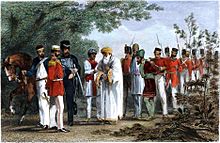
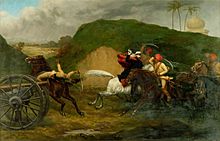
The British, East India Company, and loyal Indian armies suffered many losses during the siege of Delhi. From the start of the siege to the city's capture, 1,254 soldiers were killed and 4,493 were wounded. During the last six days of fighting, 992 were killed, 2,795 were wounded, and 30 were missing. Of these, 1,677 were loyal Indian soldiers. It is hard to say how many rebels and their supporters were killed, but it was likely more than 5,000.
It is also impossible to know how many civilians died during the fighting in Delhi. This includes those killed by rebels, by the British, or caught in the crossfire. After the siege, many civilians were forced to leave the city and live in temporary camps. There was no way to feed them until order was restored. The British, Sikh, and Pakhtun soldiers were very harsh. For four days after the city fell, there was widespread looting.
The British wanted revenge for the killing of their people in Delhi and other parts of India. They did not take many prisoners. Hundreds of rebel prisoners and suspected rebels were hanged without proper trials. Some British army officers wanted to be more forgiving, but East India Company officials like Theophilus Metcalfe wanted revenge.
Bahadur Shah and three of his sons hid at Humayun's Tomb, south of Delhi. He was told that the British only wanted to punish the rebellious soldiers, and he would be safe. On September 20, a group led by William Hodson took him into custody, promising him mercy. He was brought back to the city. The next day, Hodson also captured two of Bahadur Shah's sons and a grandson, but without any promises of safety. Hodson then executed the three princes at Khooni Darwaza (Bloody Gate), claiming a mob was about to free them. Their heads were later shown to Bahadur Shah. He was put on trial by the British military. In 1858, he was sent away to Rangoon in British-controlled Burma after being found guilty.
By taking back Delhi, the British dealt a huge blow to the Indian rebellion. It also freed up troops to help in other battles, like the relief of Lucknow, leading to another British victory.
A total of 29 Victoria Crosses were given for bravery during the Siege of Delhi. A special medal clasp was also created for the Indian Mutiny Medal.
Images for kids



